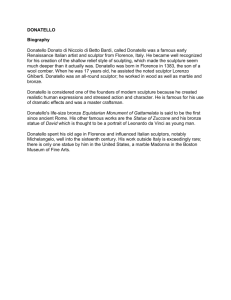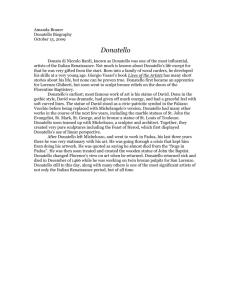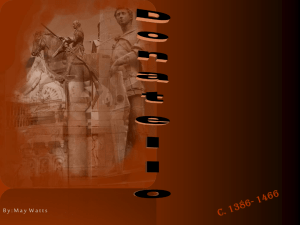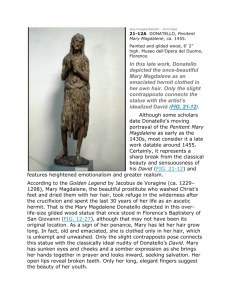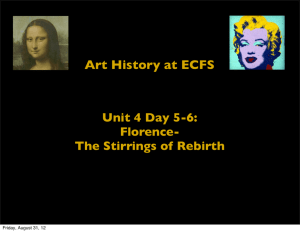donatello1 - Kendell Glauser
advertisement
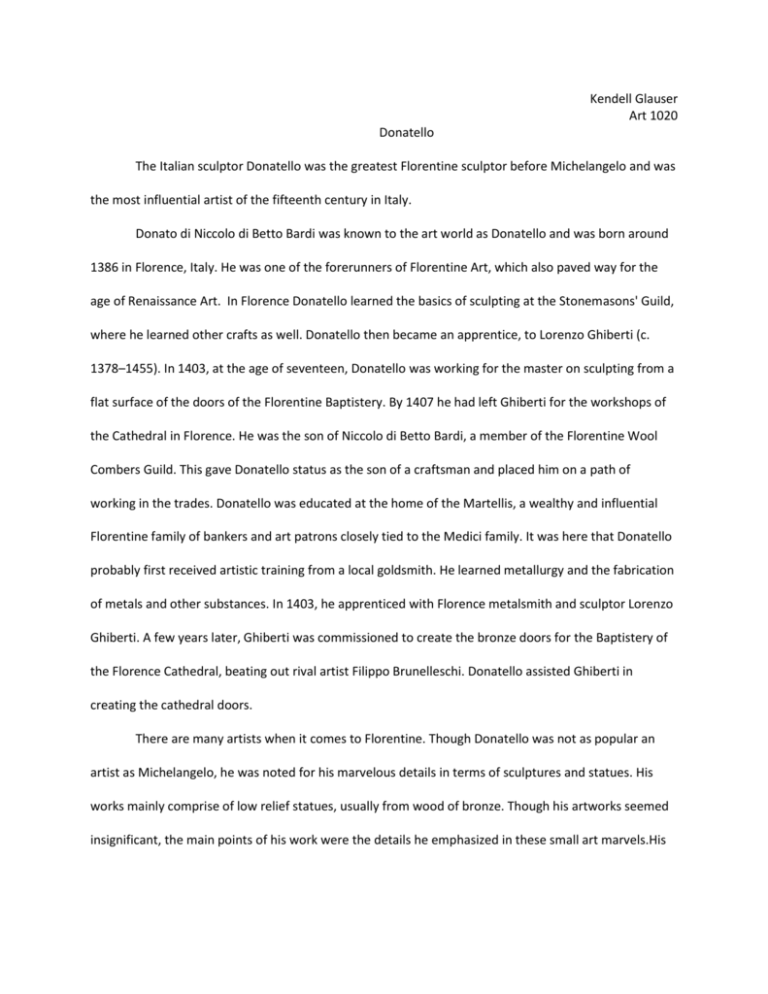
Kendell Glauser Art 1020 Donatello The Italian sculptor Donatello was the greatest Florentine sculptor before Michelangelo and was the most influential artist of the fifteenth century in Italy. Donato di Niccolo di Betto Bardi was known to the art world as Donatello and was born around 1386 in Florence, Italy. He was one of the forerunners of Florentine Art, which also paved way for the age of Renaissance Art. In Florence Donatello learned the basics of sculpting at the Stonemasons' Guild, where he learned other crafts as well. Donatello then became an apprentice, to Lorenzo Ghiberti (c. 1378–1455). In 1403, at the age of seventeen, Donatello was working for the master on sculpting from a flat surface of the doors of the Florentine Baptistery. By 1407 he had left Ghiberti for the workshops of the Cathedral in Florence. He was the son of Niccolo di Betto Bardi, a member of the Florentine Wool Combers Guild. This gave Donatello status as the son of a craftsman and placed him on a path of working in the trades. Donatello was educated at the home of the Martellis, a wealthy and influential Florentine family of bankers and art patrons closely tied to the Medici family. It was here that Donatello probably first received artistic training from a local goldsmith. He learned metallurgy and the fabrication of metals and other substances. In 1403, he apprenticed with Florence metalsmith and sculptor Lorenzo Ghiberti. A few years later, Ghiberti was commissioned to create the bronze doors for the Baptistery of the Florence Cathedral, beating out rival artist Filippo Brunelleschi. Donatello assisted Ghiberti in creating the cathedral doors. There are many artists when it comes to Florentine. Though Donatello was not as popular an artist as Michelangelo, he was noted for his marvelous details in terms of sculptures and statues. His works mainly comprise of low relief statues, usually from wood of bronze. Though his artworks seemed insignificant, the main points of his work were the details he emphasized in these small art marvels.His specialty was more in sculptures and statuettes than painting. His works were also noted to have the concept of perspectival illusionism when it came to his shallow relief. Early artworks There were no known commentaries on his private life, though it was said that he had no regret saying that he was in fact a homosexual. And strangely enough, there was not a mention about his sexuality and preferences discovered in the archives of Florence. One of Donatello's earliest known works is the life-sized marble David done in 1408. Donatello's new style was confirmed in the famous St. George, carved in marble around 1416 and 1417. Even more significant is the little marble relief St. George and the Dragon, that decorates the base. The marble was ordered in 1417, and the relief was completed shortly afterward. This is an important date, for the relief is the earliest example in art of the new science of perspective used to create a measurable space for the figures. Up to this time artists had conceived of a flat background in front of which, or in which, the figures were placed; now the low, pictorial forms seem to emerge from atmosphere and light. Middle period His major art commissions include his now famous artwork, David in Bronze, who was then authorized by Cosimo I De Medici, known forerunner art patron in Florence, for the Palazzo Medici in the year 1430 AD (Anno Domini). By the time the statue was finished, it was then considered the firstever free-standing nude statue since the ancient era. It was also the primary statue among the Renaissance Sculptures, it was very strange however the position that he was posed in. By the time Medici was Exiled, his master, Donatello stayed in Rome until 1433. His two artworks in the city was the Giovanni Crivelli’s Tomb located in Santa Maria, a province of Aracoeli. And his other work was the Saint Peter’s Basilica Ciborium. By the time he returned to Florence, he voluntarily commissioned for the construction of the marble pulpit of the façade of the Cathedral Prato, which was the considered the last project with Michelozzo. By this time, Donatello was gaining a reputation for creating imposing, larger-than-life figures using innovative techniques and extraordinary skills. His style incorporated the new science of perspective, which allowed the sculptor to create figures that occupied measurable space. Before this time, European sculptors used a flat background upon which figures were placed. Donatello also drew heavily from reality for inspiration in his sculptures, accurately showing suffering, joy and sorrow in his figures’ faces and body positions. It was ordered in 1418 for the pope apartments in Saint Maria Novella Donatello's style in relief sculpture reached its height in the bronze Feast of Herod, completed in 1427 for the font in the Baptistery. This painting depicts when the queen demanded the head of John the Baptist and it being presented to them on a platter shortly after the execution of John the Baptist. Other sculptors also executed reliefs for the front of the Baptistery. In Donatello's very low relief composition he nearly, but purposefully, avoided the accurate construction of one-point architectural perspective. Around 1425 Donatello entered into partnership with Michelozzo, a sculptor and architect, with whom he made a trip to Rome after 1429. Vasari states that Donatello went to Rome with architect Filippo Brunelleschi. This would have been much earlier, perhaps in 1409; but there is no document to confirm such a trip. With Michelozzo he produced a series of works, including the tomb of Pope John XXIII in the Baptistery, Florence, and the tomb of Cardinal Brancacci in Saint Angelo a Nilo, Naples, both of which were in progress in 1427. The first of these established a type of wall tomb (burial chamber) that would influence many later Florentine examples. Probably just after the trip to Rome, Donatello created the well-known gilded limestone Annunciation tabernacle (place of worship) in Sta Croce, Florence, enclosing the pair of Gabriel and the Virgin Mary. He was also commissioned to carve a Singing Gallery for the Cathedral to match the one already begun by Luca della Robbia (both now in the Museo dell'Opera). Using marble and mosaic, Donatello presented a classically inspired frieze (a decorative band) of wildly dancing putti. It was begun in 1433, completed six years later, and installed in 1450. Later works Much of Donatello's later work demonstrates his understanding of classical art. For example, the bronze David in the Bargello is a young boy clothed only in boots and a pointed hat. This enigmatic figure is in all probability the earliest existing freestanding nude since antiquity. From 1443 to 1453 Donatello was in Italy, where in the Piazza del Santo he created the colossal bronze equestrian with horse, monument to the Venetian condottiere called Gattamelata. It was the first important sculptural repetition of the second-century equestrian statue of Marcus Aurelius in Rome. Donatello portrayed Gattamelata as the ideal man of the Renaissance, a period marked by artistic awakening between the fourteenth and sixteenth centuries. Another major commission in Padua was the high altar of Saint Antonio, and was decorated with four large narrative reliefs representing the life of Saint Anthony, smaller reliefs, and seven life-sized statues in bronze, including a seated Madonna and Child and a bronze Crucifixion a representation of Christ on the cross. Donatello had earlier made remarkable experiments with illusions of space in his large stucco medallions for the Old Sacristy of Saint Lorenzo in Florence; now his major bronze Paduan reliefs present an explosive idea of space with sketchy figures and a very excited and busy surface. The influence of these scenes on painters in northern Italy was to prove enormous and long lasting. Back in Florence, the aged Donatello carved a haunting, unhealthy Mary Magdalen from poplar wood for the Baptistery (1454–1455). Romantically distorted in extreme ugliness, the figure of the saint in the wilderness originally had sun-tanned skin and gilding (a thin coat of gold) on her monstrous hair. In 1456 Donatello made an equally disturbing group in bronze of Judith cutting off the head of Holofernes. Now in the Piazza della Signoria, Florence, it was originally commissioned, apparently as a fountain, for the courtyard of the Medici Palace. On Donatello's death on December 13, 1466, two unfinished bronze pulpits platforms for preaching were left in Florence. On one are relief panels, showing the torture and murder of Christ by means of distorted forms and wildly emotional actions. Finished by his pupil Bertoldo di Giovanni, the pulpit scenes reveal the great master's insight into human suffering and his exploration of the dark realms of man's experience. The statue of David The David by Donatello in Museo Nazionale del Bargello. Florence. The height of the bronze statue of David by Donatello is 158 cm. David was the chosen subject of the statue as he had become a symbol of the Florentine Republic. In the statue of David by Donatello David wears a crown of leaves, reminiscent of the Roman heroes of antiquity reflecting the interest that Donatello had in classical art. Mary Magdalene The Mary Magdalene statue stands 6 foot two inches and was sculpted in wood with gold. The statue of Mary Magdalene was sculpted by Donatello between 1454 and 1455. The feast of Herod The Feast of Herod is a bronze relief sculpture created by Donatello circa 1427. It appears on the baptistry of the Siena Cathedral in Italy. It is one of Donatello's earliest relief sculptures. The sculpture is noted for Donatello's use of perspective. The sculpture depicts the Beheading of St. John the Baptist after Salome asks Herod Antipas for his head on a platter. The scene depicts an executioner presenting the severed head, and Herod reacting in shock. Judith and Holofernes depicts the assassination of the Assyrian general Holofernes by Judith and is remarkable for being one of the first Renaissance sculptures to be conceived in the round. As I have studied and researched more about this artist Donatello I realize that something tragic had probably happened in his life, or he was just always depressed about life. He comes across in his paintings as very morbid and sad. I enjoy most of his work and understand now that what he did as a sculpting changed how the world viewed everything, he was a pioneer in what he did. As an artist of course he was very lucky being able to study under some very good painters and metal workers he is fortunate how everything turned out for him, I guarantee however he worked very hard to do it and he would not consider it luck. His painting are very unique and they all have a purpose as to why he drew them, as do most drawing. He really shows what he is feeling in each piece of work that he does. We all know about the famous David statue, it was one of the first nude statues to ever be done, I find this very disturbing that a man would sculpt another naked man but the details of the statue are amazing. This doesn’t surprise me now knowing that Donatello was homosexual. I didn’t even know that Donatello was the one that sculpted the infamous David statue. My very favorite sculpture that Donatello did was the one of the feast of Herod, my favorite painting that I have grown up loving was the one of the last supper, this painting is very similar to it but is done so that it is two dimensional, the story in the bible of how the queen demanded to have the head of John the Baptist because she was upset with and what he had done, even though in all reality he had only done what Jesus had told him to. She was upset, demanding the head of John the Baptist, He was executed and had his head chopped off. In this painting is where she is being presented the head of John the Baptist on a platter. The main reason I picked Donatello was because of the ninja turtle, however the more I learned about him I have found that he is a very interesting person and rather strange, like most artist in this time period very detailed and twisted. I enjoy his art very much because of how unique it is and how he was able to do what he wanted. Donatello St. George c. 1420 Marble 6’5” (1.95 m) Museo Nazionale del Bargello, Florence “The legs move, the arms are ready, the head alert, and the whole figure acts; by virtue of the character, the manner and form of the action presents to our eyes a valiant, invincible, and magnanimous soul.” – Francesco Bocchi, sixteenth century. Donatello’s St. George was originally commissioned by the guild of armorers and sword makers (Arte dei Corazzai e Spadai) for their niche outside Orsanmichele, but was moved in the nineteenth century to a museum. St. George was the patron saint of the guild. Suggestions of guild members’ handiwork can be found on the figure: the socket holes in his hands still bear traces of corroded metal, and drill holes in various places imply that he may have had a helmet, sword or spear, belt and sheath. It is possible that the cross on the saint’s shield is not only the emblem of the Christian saint, but a reference to the red cross on white ground, which is also the emblem of the Florentine popolo. The emblem also appears at the top of the Palazzo Vecchio. (Hartt, History of Italian Renaissance art 191192) St. George is an example of Donatello’s emotional realism and his ability to create narratives and characters. While the saint maintains a strong contropposto, appearing ready to fight, there is genuine fear in his eyes. This story could also relate to contemporary events in Donatello’s time, given that the armorer and sword makers’ guild gained importance some years earlier when Tuscany was invaded by Ladislaus, the King of Naples. The fear and the bravery of St. George would become relevant again during World War II. The figure had been removed to a deposit outside Florence during the Second World War. When the Germans began to retreat north, so did many of Florence’s great works, including St. George. Statue of Gattamelata at Padua After Erasmo of Narni's death in 1443, the mercenary’s family paid for a sculpture in his honor. Measuring 340 x 390 cm (the base measuring 780 x 410 cm,[2] it is the first Renaissance equestrian statue and the first to reintroduce the grandeur of Classical equestrian portraiture.[3] After its conception, the statue served as a precedent for later sculptures honoring military heroes.[4] The statue, as were all bronze statues of this time, was made using the lost wax method. The statue sits on a pedestal, and both the condottiero and his horse are portrayed in life size. Instead of portraying the soldier as larger-than-life, as in the classical equestrian statue of Marcus Aurelius in Rome, where a sort of hierarchy of size demonstrates the subject's power, Donatello used emotion, position, and symbolism to convey the same message. Thus, Donatello makes a statement of the power of the real-life individual; he does not need to embellish or make grander whom Gattamelata was – the simple depiction of the real man is enough to convey his power. The pedestal under the horse is composed of two reliefs toward the top with fake doors underneath. The doors symbolize the gates of the underworld, lending the feeling of a tomb, though the monument was never a burial place.[5] One relief shows Gattamelata's coat of arms flanked by two putti that are pointing to it. The other relief is of angels displaying battle armor
